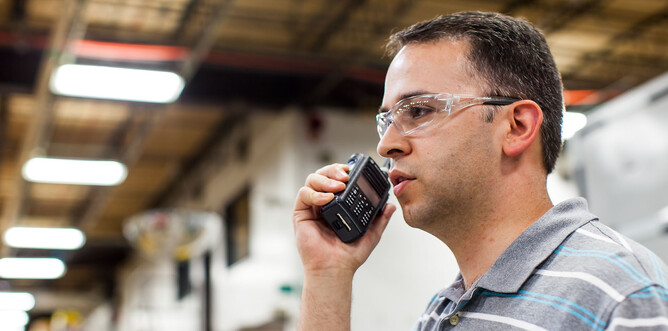If you are new to two way radios, it can be easy to feel overwhelmed by all of the lingo and the specific requirements of the technology. That’s why we are listing some handy tips to ensure you are prepared.
Think Before You Speak
A key feature of two way radios is the idea that only one person can talk at a time, this eliminates any cross-talk and keeps the line clear so important messages can always get through.
A way that you can ensure that this happens is by making sure you only have the ‘talk’ button pressed down if you are ready to speak. If you press the button before you have fully formulated your thoughts, you are stopping others from joining in on the discussion and could even prevent an emergency message from getting through!
Identify Yourself
As often in a work environment there are more than two people on the same channel, it’s important that people know who you are and who your message is directed at. In order to do this, announce who is speaking as well as the person whose attention you are trying to get at the beginning of your message and allow them to respond.
Keep It Short and Sweet
As stated earlier, two way radios work on a system that only allows one person to speak at a time. This means it’s essential that you don’t ramble and rant, instead you keep your messages concise and compact to ensure not only the key points are understood clearly, but that any other messages that may need to go through can still occur.
Take a Second
After pressing the ‘talk’ button, make sure you wait a second before speaking. This is because there is a short delay before your radio starts broadcasting fully. Doing this ensures the beginning of your message does not get cut off.
Know the Lingo
Because of the way that two-way radio works, it makes communicating far easier if everyone uses that same vocabulary and phrases. Here is a handy list of them that you can implement into your communication to increase the effectiveness and clarity of your message.
- Over – I’ve finished speaking
- Say Again – Repeat your last message
- Stand-by – I acknowledge your transmission, but can’t respond right now
- Go Ahead – I can respond, go ahead with your message
- Roger – Message received and understood
- Affirmative / Negative – Yes / No
- Out – Conversation is finished, the channel is clear for other users.
In addition to this there is a phonetic alphabet (the same one used by NATO) that is good for reading out product codes or in the event that someone mishears something.
| A | Alpha | N | November |
| B | Bravo | O | Oscar |
| C | Charlie | P | Papa |
| D | Delta | Q | Quebec |
| E | Echo | R | Romeo |
| F | Foxtrot | S | Sierra |
| G | Golf | T | Tango |
| H | Hotel | U | Uniform |
| I | India | V | Victor |
| J | Juliet | W | Whiskey |
| K | Kilo | X | X - Ray |
| L | Lima | Y | Yankee |
| M | Mike | Z | Zulu |

